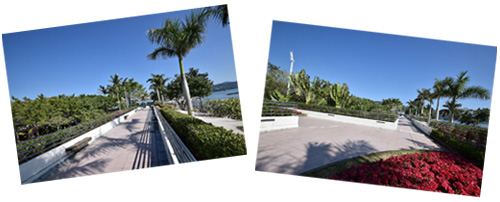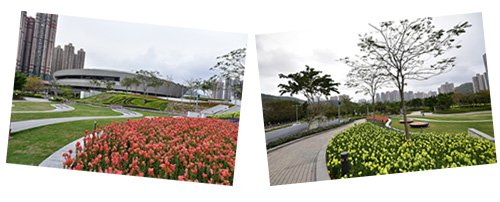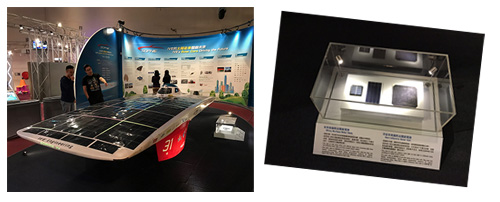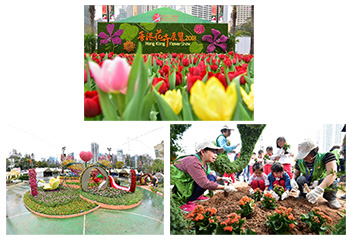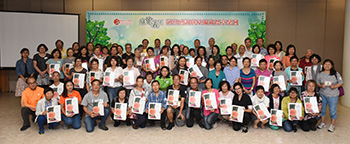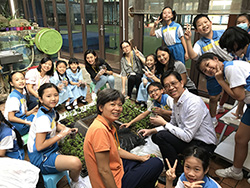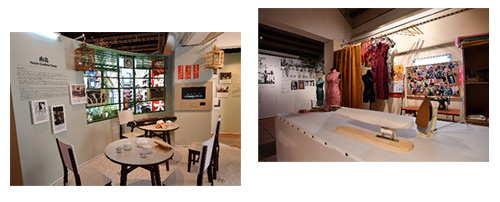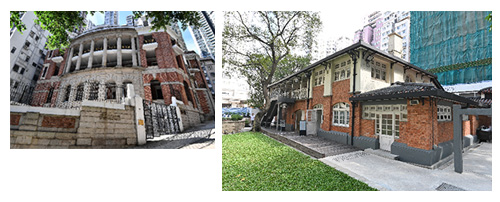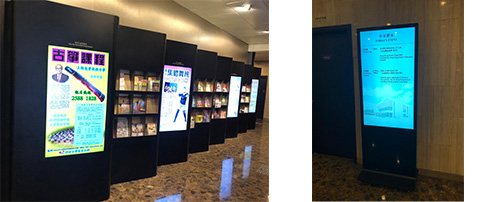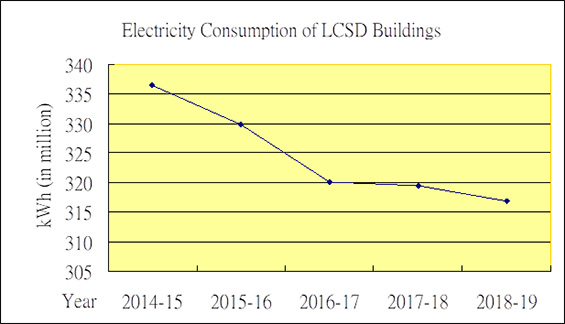 Environmental Report 20168Leisure and Cultural Services Department
Environmental Report 20168Leisure and Cultural Services Department
Chapter 3 - Environmental Management and Performance
(A) Providing Aesthetically Pleasing Open Space and Promoting Greening and Horticulture
| 3.1 | In providing aesthetically pleasing open space and promoting greening and horticulture, we have five areas of work. They are –
|
| 3.2 | (I) Provision of Open Spaces that are Aesthetically Pleasing
|
| 3.3 | (II) Beautification of Existing Landscape Areas
|
| 3.4 |
(III) Planting Programme
|
| 3.5 | (IV) Education and Promotion on Environmental Protection (a) Horticulture Courses for the General Public During 2018, the Department conducted 50 horticulture courses for 1 500 participants. (b) Guided Visits for Schools and Non-governmental Organisations (NGOs) The Department organised 878 guided visits for 30 508 participants from schools and NGOs. They included 661 school guided visits for 23 180 school children at the Hong Kong Zoological & Botanical Gardens, Green Education Resource Centre, Kowloon Park, Hong Kong Park, Tai Po Waterfront Park, Tuen Mun Park and Boundary Street Nursery. The guided visit was designed having regard to the curriculum on environmental education for primary schools. Besides, 200 visits were arranged for 6 855 children from kindergartens to tour around Kowloon Park and Hong Kong Park. Children were introduced the basic knowledge and concept of plants, environmental conservation and appropriate manners for visiting parks. Free guided visits were also arranged for 473 participants from 17 NGOs to tour around the Green Education Resource Centre at Kowloon Park. (c) Conservation Courses for Uniformed Groups The programmes provided a wide range of courses in gardening and arboriculture and aimed at promoting nature conservation. A total of 12 conservation courses were organised for 407 participants of the uniformed groups in 2018. Participants were involved in group discussions, lectures, guided visits and practical learning. (d) Seminar and Gallery on Environmental Protection
|
| 3.6 | (V) Greening Activities The Department continuously promotes a green culture in the community through a series of educational and community involvement programmes. A total of 3 223 greening activities were organised for the year of 2018, including –
|
(B) Preserving Assets of Our Heritage
| 3.7 | The Department, through the Antiquities and Monuments Office (AMO), is committed to preserving Hong Kong’s cultural heritage. Under the Antiquities and Monuments Ordinance, the Antiquities Advisory Board (AAB) advises the Secretary for Development, i.e. the Antiquities Authority, on matters relating to antiquities and monuments. The AMO works closely with AAB and acts as the Authority’s executive arm under the Ordinance. |
| 3.8 | In addition, the AMO plays an important role in monitoring Environmental Impact Assessment for Designated Projects under Environmental Impact Assessment Ordinance (Cap. 499) insofar as their impacts on antiquities and monuments is concerned. The work involves inspecting sites of cultural heritage, examining mitigation measures to avoid any possible damage to the sites and conducting, where necessary, rescue excavations at archaeological sites and cartographic recording of historic buildings. |
| 3.9 | The AMO also organises educational programmes to promote heritage preservation among the public. |
| 3.10 |
The Department firmly believes that cultural heritage not only enhances our built environment and the natural landscape, but also provides an essential and irreplaceable link between the past, the present and the future. It forms the basic points of reference for our cultural identity and traditions.
|
| 3.11 | Up to end 2018, there were 120 declared monuments, including 102 historic buildings and structures as well as 18 rock carvings, forts, stone inscription and archaeological sites. |
| 3.12 | The AMO carried out restoration and repair works on a number of monuments and historic buildings, mainly including St. John’s Cathedral in Central, Maryknoll Convent School in Kowloon Tong and I Shing Temple in Yuen Long. |
| 3.13 | Archaeological surveys and excavations necessitated by small-scale development projects such as small house development in the New Territories were conducted by the AMO in Sai Kung, Lamma Island, and Lantau Island. The archaeological surveys and excavations have successfully salvaged the archaeological heritage, if any, found at the sites. |
| 3.14 |
On education and publicity, the AMO organised a wide variety of educational and publicity programmes, such as exhibitions, displays, lectures, guided tours and workshops, to promote heritage conservation. A long-term exhibition on the archaeological and built heritage has been staged in the Hong Kong Heritage Discovery Centre. In total, the office conducted 1 459 heritage educational programmes and produced 14 publications in 2018.
|
(C) Practising Waste Reduction and Energy Saving
| 3.15 | We proactively explore ways to promote paper saving, energy saving and waste reduction, including conducting energy audits to identify good energy management practices. Measures/ housekeeping practices adopted are shown in the ensuing paragraphs. |
(I) Paper Saving
| 3.16 | The Department continued to adopt good practices on paper saving using “reduce and reuse” strategy, particularly in replacing paper-based correspondences with electronic means. In 2018, we also made the following endeavours –
|
(II) Energy Saving
| 3.17 | The Government has set a new target of 5% saving in the electricity consumption of government buildings under comparable operating conditions from the financial year (FY) of 2015-16 to 2019-20, using the electricity consumption in FY 2013-14 as the baseline. |
| 3.18 | To achieve the target of 5% saving, we have continued our effort to manage our resources responsibly. Energy-saving building services installations and environmental-friendly materials were used whenever applicable. |
| 3.19 | The electricity consumption of government buildings under LCSD in FY 2018-19 was 316.9 million kWh. The table below shows the electricity consumption of LCSD buildings in the past five years from FY 2014-15 to FY 2018-19.
|
(a) Change in Electricity Consumption
| 3.20 | The electricity consumption of government buildings under LCSD continued to decrease from 319.5 million kWh to 316.9 million kWh in FY2018-19 as compared to FY2017-18 under comparable operating conditions. The decrease was mainly due to sections/venues’ implementation of practicable housekeeping measures and best practices for energy savings, including switching off unnecessary lights, air-conditioning installation, equipment and appliances, replacement of equipment by energy efficiency models, etc. The details of housekeeping measures for energy saving were provided in paragraphs 3.22 to 3.24 below. |
| 3.21 | The change in electricity consumption has factored in significant changes in opening/closure of venues/facilities, addition/reduction of services, addition/removal of plants/equipment, extended/shortened service hours, increased/decreased demand for services, change of chairmanship of Building Management Committee1, etc. for a like-to-like comparison. 1 The electricity consumption of a Municipal Services Building is counted towards the department holding the Building Management Committee chairmanship. |
(b) Housekeeping Measures for Energy Saving
| 3.22 | The following housekeeping measures for energy saving were commonly adopted in the Department’s offices and venues (including leisure venues, performing arts venues, libraries and museums) in 2018 –
|
| 3.23 | Apart from the above commonly adopted housekeeping measures, some venues also implemented other practicable measures that could address their operational characteristics or specific environment for energy saving –
|
| 3.24 | At the Headquarters building, the following practicable measures were also implemented –
|
| 3.25 | We will continue our effort to achieve the Government’s new target of saving and identify energy management opportunities specific to the operational and technical characteristics of individual buildings by conducting energy audit for buildings with annual electricity consumption of more than 500,000 kilowatt hour in 2013-14. |
(III) Water Saving
| 3.26 | The fresh water consumption of government buildings under LCSD in 2018 were 13,252,768 M3. Major water conservation measures adopted are listed below –
|
(IV) Waste Reduction
| 3.27 | Waste reduction and other green measures adopted are listed below –
|
(V) Carbon Reduction
| 3.28 | As part of the Government’s efforts in combating climate change, we conducted annual carbon audits for our major buildings with annual electricity consumption over 500 000 kilowatt hour (kWh) so as to assess the carbon performance and identify room for emissions reduction. The carbon performance summary was uploaded to the Department’s website. |
(VI ) Environmental Awareness among Staff
| 3.29 | For raising environmental awareness and promoting waste reduction, saving energy and natural resources among staff – Environmental Awareness among Staff
|
(VII ) Clean Air Charter
| 3.30 | On 27 November 2006, the Chief Executive signed the Clean Air Charter on behalf of the Government at the “Business for Clean Air” seminar organised by the Hong Kong General Chamber of Commerce. The Charter was initiated by the business sector in support of the Government’s appeal to improve air quality in Hong Kong. | ||||||
| 3.31 | As at 31.12.2018, we had a fleet of 154 vehicles. The total mileage was 1 828 703 km in 2018 and the fuel consumption was 419 731 litres. The related emissions were about 8 043 kg of nitrogen oxides (NOx) and 494 kg of respirable suspended particulates (RSP)2. We have implemented the following measures in support of the Government’s policy to improve air quality in Hong Kong – 2. The indirect emissions from vehicle fuel are calculated according to the formulae set out in the Guide to Clean Air Charter Report Writing published by EPD in Jan 2008.
|
||||||
| 3.32 | For improving indoor air quality (IAQ) and providing quality services to the public, we engaged EMSD to carry out proper maintenance and retrofitting works for the ventilation and air-conditioning systems at our offices and venues. | ||||||
| 3.33 | In support of the Government’s drive of improving IAQ, we also participated in the IAQ Certification Scheme and engaged accredited IAQ Certificate Issuing Body to carry out regular IAQ inspection for LCSD venues/facilities served by central air-conditioning systems wherever practicable. In 2018, around 215 LCSD venues/facilities had participated in the Scheme. |
(D) Minimising Air and Noise Pollution in Organising Leisure and Cultural Activities
| 3.34 | We monitored closely the generator and machinery installed for activities to ensure that dark smoke emission would not exceed the prescribed requirement as stipulated in the relevant Regulations. |
| 3.35 | We monitored the noise level of outdoor events and ensure that they were within the limits set in the relevant Regulations. |
| 3.36 | Following the amendments to the Smoking (Public Health) Ordinance (Cap 371) in 2006, statutory no smoking areas have been extended to cover all indoor workplaces and public places as well as some outdoor public places. The Department has implemented the smoking ban in these premises with effect from 1 January 2007. |

